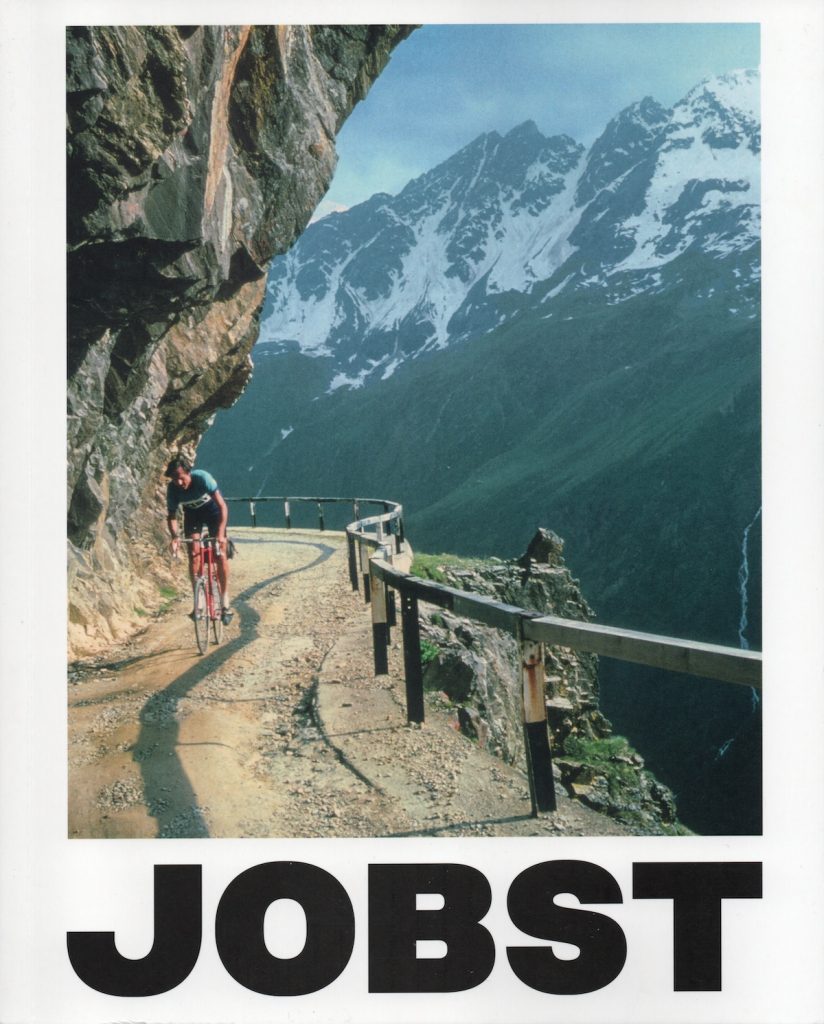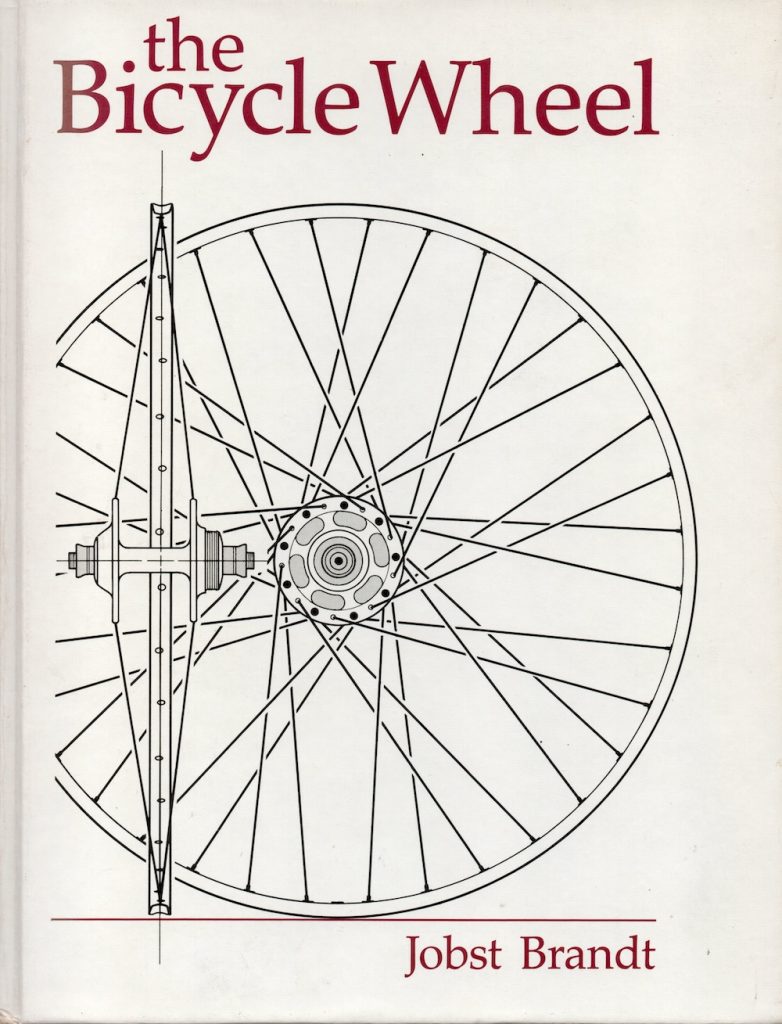This book is a nicely presented tome all about the American cycle pioneer Jobst Brandt. I'd long been aware of Brandt not only because I bought a copy of his excellent book on the spoked bicycle wheel (The Bicycle Wheel), which includes guidance on wheelbuilding, but though reading his old USENET posts on matters pertaining to bicycle technology. Many of those old posts have been preserved at Sheldon Brown's website (itself maintained some years after Brown died in 2008). Brandt was strikingly forthright and not shy in making his views known through these early internet posts. However, I'm getting a little ahead of myself here.

Brandt was born in New York city in 1935 to German parents who'd left Germany as the Nazis rose to power. Brandt's family moved to California while Brandt was a child, and it's fair to say that California was, along with the Alps, a location which drove his cycling and his love of bike engineering. Brandt studied engineering at Stanford University before two years' military service in Germany. His early trips cycling in the Alps at that time featured what to modern eyes are eye-wateringly inappropriate bikes (e.g. narrow wheels with tubular tyres)initiated a love affair with alpine cycling with minimal luggage. Professionally he seems to have been a bit of a polymath moving between technical writing to mechanical and eventually electronic engineering. Back in the USA, he began long mountain rides with a growing group of friends indirectly influencing the development of mountain bikes in the mid-70s - though he doesn't seem to have really approved of mountain bikes. Throughout all this, his cycling was documented with many photographs, and some of those used in this book are truly stunning.
The authorship of this book is a little confusing to me - it seems to rest with several people who conducted interviews and edited the sections written by Brandt.
The parts I found most interesting related to the bike riding itself and especially the alpine cycling, and also of course his approach to better understanding the mechanical engineering of bicycles, and his attempts to dispel the myths that so often circulate. This is really evident in his extensive writings in the USENET groups, where he could (and frequently did) come across as quite brutal in his approach. An example would be when he was working with Avocet and introduced tyres with no tread - he knew from observation of motorcycles and drag racing cars that tread did not equal better grip. With Avocet he devised ways of establishing this, and bringing this to online discussions he really pushed the benefits of smooth tyres in increased traction and pointed out that owing to the shape and size of the tyre's contact patch with tarmac, bicycle tyres could not aquaplane.
In a similar vein, he took the time to figure out the mechanics of spoked bicycle wheels, writing The Bicycle Wheel, a short but influential description of how spoked bicycle wheels work and how to build them.

Brandt worked extensively with Avocent, with input into saddle design, shoe design and also one of the first (if not the first) electronic bike computers. Back in the 1990s, my first bike computer was a fluo green Avocet 30.
Jobst Brandt Ride Bike! covers all this, mostly through snippets from interviews with those who lived, rode or worked with Brandt, but also with some longer sections apparently written by Brandt. It's a really engaging read if you're into reasonably recent cycling history, but probably less so if you aren't (but then you'd not be attracted into picking this up in the first place). The whole book is copiously illustrated with photographs, frequently of a very high standard.
Brandt died in 2015, several years after a serious bike accident which curtailed his cycling and led to a period of ill-health. This book is a fitting memorial to him.
Jobst Brandt Ride Bike! is available from the publisher, Isola Press.
Jobst Brandt Ride Bike! - Hardcover ISBN: 9781739126711 / softcover ISBN: 9781739126728
I think Isola Press also sell The Bicycle Wheel, though I'm unsure who publishes it currently - my 2nd Edition is published by Avocet.
Both books are also available via Amazon.


 I am a pretty avid reader of popular science books, but generally speaking I've mostly read books with a general emphasis on biology, particularly evolutionary biology. From Stars to Stalagmites is therefore a bit different from my usual reading fare, taking a chemist's view on the world. In essence, the book spends 16 chapters explaining how we know stuff. Stuff ranging from the age of the Earth to how CFCs were incriminated as the cause of the ozone holes. Many of these accounts are told with specific reference to the people who shaped the theories and the science. I don't mean just the scientists - policy-makers and politicians also feature highly - a good example being the chapters on figuring out the cause of the ozone hole and on global warming.
I could summarise this book as "a collection of stories about stuff", but that would ignore the central theme that comes across as one read through the book: how we know how natural processes work, and how we can use this understanding to probe the deep history of our planet, figure out how to rescue our planet from anthropogenic destruction and so forth.
On reflection some, if not all, of the chapters come across as excellent material for presentations. Whether such has been the origins of the work or not, I do believe that the book itself would have benefited from a bit more in the way of illustration...
For me, stand out chapters include the opening chapter on the age of the Earth (Chapter 1), that on Fritz Haber, the First World War and explosives (Chapter 6), and the 14th Chapter on why water is weird. But I guess those preferences reflect my interests; the book is consistently interesting and clearly written.
In dealing with the evolution of ideas about the Earth's antiquity, Braterman effectively sets the stage for all the controversies manufactured by the biblical literalists who insist in (mis)interpreting the bible to deduce that the Earth is a mere 6000 years (give or take a little). The chapter takes the reader on a journey in the changing scientific understanding of earth science, which neatly encapsulates the nature of scientific discovery. I think this example illustrates the value of this book. It's not necessarily in its factual content, but in the way rational and thoughtful investigation of the world and its material phenomena can lead to clearer understanding of the world around us. And more than this, several chapters describe how current understanding can and does change as science advances, both in terms of techniques and in the application of knowledge from disparate areas of investigation.
To conclude, From Stars to Stalagmites is a valued addition to my bookshelf and a fine example of popular science writing.
*Disclosure: Paul Braterman is a BCSE committee member, as am I.
[cross-posted from
I am a pretty avid reader of popular science books, but generally speaking I've mostly read books with a general emphasis on biology, particularly evolutionary biology. From Stars to Stalagmites is therefore a bit different from my usual reading fare, taking a chemist's view on the world. In essence, the book spends 16 chapters explaining how we know stuff. Stuff ranging from the age of the Earth to how CFCs were incriminated as the cause of the ozone holes. Many of these accounts are told with specific reference to the people who shaped the theories and the science. I don't mean just the scientists - policy-makers and politicians also feature highly - a good example being the chapters on figuring out the cause of the ozone hole and on global warming.
I could summarise this book as "a collection of stories about stuff", but that would ignore the central theme that comes across as one read through the book: how we know how natural processes work, and how we can use this understanding to probe the deep history of our planet, figure out how to rescue our planet from anthropogenic destruction and so forth.
On reflection some, if not all, of the chapters come across as excellent material for presentations. Whether such has been the origins of the work or not, I do believe that the book itself would have benefited from a bit more in the way of illustration...
For me, stand out chapters include the opening chapter on the age of the Earth (Chapter 1), that on Fritz Haber, the First World War and explosives (Chapter 6), and the 14th Chapter on why water is weird. But I guess those preferences reflect my interests; the book is consistently interesting and clearly written.
In dealing with the evolution of ideas about the Earth's antiquity, Braterman effectively sets the stage for all the controversies manufactured by the biblical literalists who insist in (mis)interpreting the bible to deduce that the Earth is a mere 6000 years (give or take a little). The chapter takes the reader on a journey in the changing scientific understanding of earth science, which neatly encapsulates the nature of scientific discovery. I think this example illustrates the value of this book. It's not necessarily in its factual content, but in the way rational and thoughtful investigation of the world and its material phenomena can lead to clearer understanding of the world around us. And more than this, several chapters describe how current understanding can and does change as science advances, both in terms of techniques and in the application of knowledge from disparate areas of investigation.
To conclude, From Stars to Stalagmites is a valued addition to my bookshelf and a fine example of popular science writing.
*Disclosure: Paul Braterman is a BCSE committee member, as am I.
[cross-posted from 